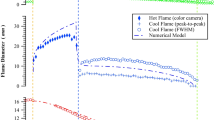Abstract
The aerodynamics of descent modules that enter dense atmospheric layers at a superobital velocity is studied using the Non-Equilibrium Radiation Aero Thermodynamics (NERAT) code and several models of the chemical kinetics of partially ionized air. The conditions of the Fire-II flight experiment are considered. It is shown that the Park, Dunn-Kang, and Martin-Bortner models extensively used in aerophysics provide satisfactory agreement between the calculated convective flux densities and those measured in the flight experiment. These models, however, predict different temperature levels in the shock layer, which can be of importance for correct calculations of radiation heat flux densities.
Similar content being viewed by others
References
E. S. Cornette, NASA TM-X-1305 (1966), p. 25.
D. R. Olynick, W. D. Henline, L. C. Hartung, and G. V. Candler, AIAA Paper No. 94-1955 (1994), p. 15.
J. H. Lewis and W. I. Scallion, NASA TN D-3565 (1965), p. 106.
D. L. Cauchon, C. W. McKee, and E. S. Cornette, NASA TM X-1389 (1967), p. 32.
D. L. Cauchon, NASA TM X-1402 (1967), p. 71.
F. Mazoue, in 2nd International Workshop on Radiation of High Temperature Gases in Atmospheric Entry (Rome, Italy, 2006), ESA SP-629, p. 8.
S. T. Surzhikov, in Proceedings of the International Workshop on Radiation of High Temperature Gases in Atmospheric Entry (Lisbon, Portugal, 2003), EAS SP-533, pp. 95–102.
S. T. Surzhikov, in Proceedings of the International Workshop on Radiation of High Temperature Gases in Atmospheric Entry (Lisbon, Portugal, 2003), EAS SP-533, pp. 111–117.
S. T. Surzhikov, in 2nd International Workshop on Radiation of High Temperature Gases in Atmospheric Entry (Rome, Italy, 2006), ESA SP-629, p. 11.
V. P. Agafonov, V. K. Vertushkin, A. A. Gladkov, and O. Yu. Polyanskii, Nonequilibrium Physico-Chemical Processes in Aerodynamics (Maninostroenie, Moscow, 1972) [in Russian].
L. V. Gurvich, I. V. Veits, V. A. Medvedev, et al., Thermodynamic Properties of Individual Substances: A Handbook, Ed. by V. P. Glushko (Nauka, Moscow, 1978) [in Russian].
M. G. Dunn and S. W. Kang, NASA CR 2232 (1973), p. 115.
J. J. Martin, Atmospheric Entry: An Introduction to Its Science and Engineering (Prentice-Hall, Old Tappan, NJ, 1966).
M. N. Bortner, General Electric Space Sciences Laboratory. Missile and Space Devision R63SD63 (1963), p. 41.
C. Park, J. Thermophys. Heat Transfer 7(3), 385 (1993).
Author information
Authors and Affiliations
Corresponding author
Additional information
Original Russian Text © S.T. Surzhikov, 2008, published in Khimicheskaya Fizika, 2008, Vol. 27, No. 10, pp. 63–76.
Rights and permissions
About this article
Cite this article
Surzhikov, S.T. A study of the influence of kinetic models on calculations of the radiation-convective heating of a space vehicle in Fire-II flight experiment. Russ. J. Phys. Chem. B 2, 814–826 (2008). https://doi.org/10.1134/S1990793108050254
Received:
Published:
Issue Date:
DOI: https://doi.org/10.1134/S1990793108050254




